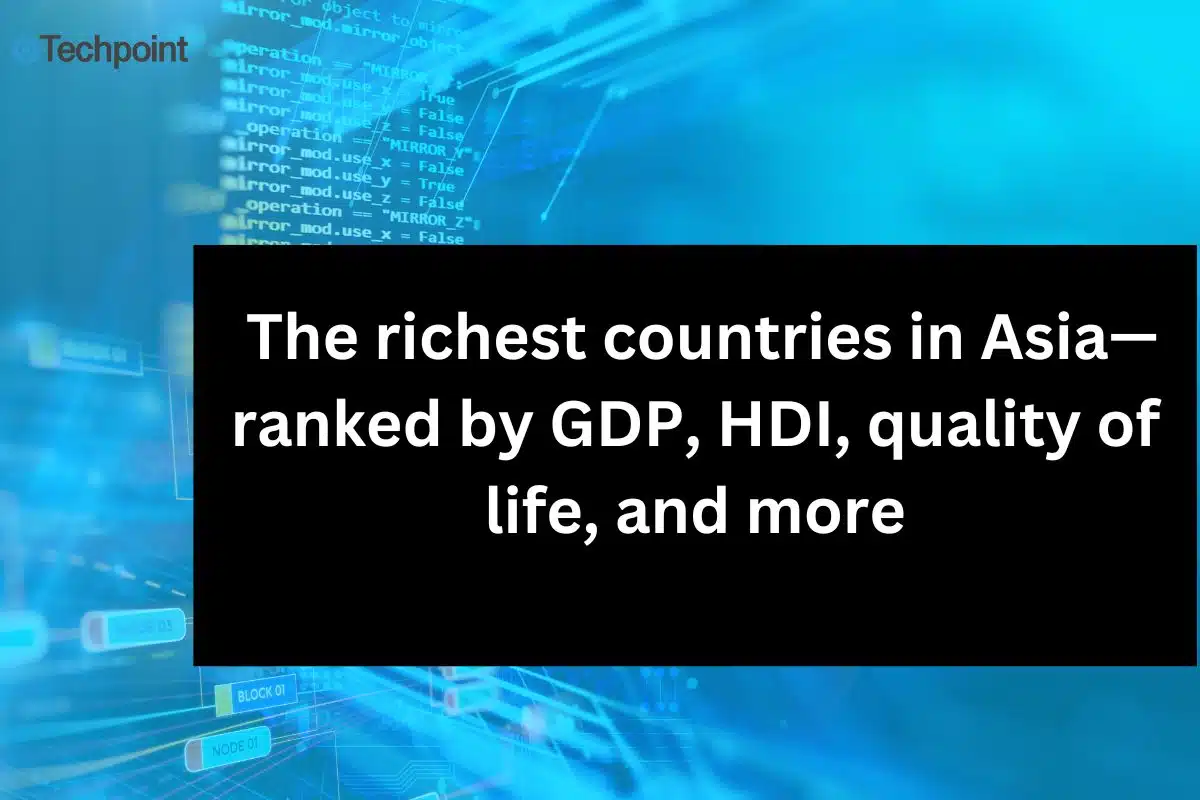When the thought of the richest countries in Asia pops up, many readers are quick to mention the ones with skyscrapers, luxury brands, or high incomes. However, measuring richness involves more than just that or even GDP. It also includes economic growth, purchasing power, and overall living standards.
Asia, the world’s most populous continent, is home to over 4.8 billion people, making up 58.89% of the global population. It is the fastest-growing economic region and boasts the largest continental economy, leading the world in nominal GDP and purchasing power parity (PPP). The continent is home to half of the world’s 20 fastest-growing economies, generates two-thirds of global growth, and accounts for 40% of global GDP. Many Asian economies are at the center of global supply chains for consumer and industrial technology, driving innovation and prosperity today.
But what truly defines richness in Asia? Is it the total GDP, GDP per capita, the quality of life, or the human development index (HDI)? Well, you will get an Asian economic analysis from diverse perspectives, which provides a complete overview.
Whether you’re an economist, business professional, investor, student, researcher, or simply a curious reader, don’t fret! This article will satisfy your curiosity and, most importantly, reveal the richest countries in Asia.
Let’s go!
Key criteria for ranking the richest countries in South America
As you are keen to know the richest countries in Asia, below are major criteria to consider:
1. GDP (Gross Domestic Product)
GDP is a major indicator of a city’s wealth, showing its total economic output. GDP measures the monetary value of goods and services produced within a country’s borders at a particular time, usually a quarter or a year. The changes in output, as measured by the GDP, are the most comprehensive gauge of an economy’s health.
GDP indicates a nation’s economic strength. It reflects the overall size and productivity of its economy. A higher GDP shows a larger economy, greater industrial output, and increased commercial activity, making it one of the most important metrics for comparing the wealth of different nations.
2. GDP Per capita
Gross domestic product (GDP) per capita is an economic metric that breaks down a country’s economic output to a per-person allocation. Economists use GDP per capita to determine the prosperity of countries based on their economic growth.
GDP per capita in Asia will be calculated by dividing the GDP of a nation by its population. Countries with a higher GDP per capita tend to be those that are industrial and developed and have smaller populations compared to others, though there are notable exceptions like the United States, which has a high population and has a high GDP per capita.
3. Human Development Index (HDI)
The HDI is a summary measurement of basic achievement levels in human development. The HDI in Asia will be an average of indexes of each of the life aspects that are examined: knowledge and understanding, a long and healthy life, and an acceptable standard of living. Each component is normalized to a scale between zero and one, and then the geometric mean of the three components is calculated.
Life expectancy at birth measures the health aspect (scaled between 20 and 85 years); education is assessed through mean years (max 15) and expected years of schooling (max 18); while the standard of living is based on GNI per capita (PPP), ranging from $100 to $75,000.
- Quality of life and economic stability
Are you aware that a country’s quality of life depends on the well-being of its citizens? Yes! It comprises factors including healthcare, education, income levels, safety, infrastructure, and environmental quality. Economic stability refers to a country’s ability to maintain steady growth, low inflation, stable employment rates, and a resilient financial system.
When it comes to the quality of life in Asia, countries like Japan and the United Arab Emirates take the top spots.
The bottom line is that, for any Asian country to thrive, you need both happy, healthy citizens and a stable economy.
Beyond the above, some other criteria define a country’s wealth. Here, you talk about innovation, environmental sustainability, and social welfare. Many Asian economies are at the center of global supply chains for consumer and industrial technology, driving innovation and prosperity.
- Innovation & technological advancement: This is a key criterion when you consider how the Asian countries have been performing towards technological advancement. This criterion involves technological progress and investment in new industries to drive economic and social growth.
- Environmental Sustainability: This involves responsible resource management, renewable energy adoption, and policies to combat climate change to ensure long-term stability.
- Social Welfare This involves proper healthcare, accessible education, social security programs, and income equality to improve citizens’ well-being and economic resilience.
Top contenders: ranking the richest countries in Asia
Singapore
Singapore, officially the Republic of Singapore, is an island country and city-state in Southeast Asia. With a population slightly above 5.86 million, the country has a high-income economy built on a business-friendly regulatory environment and strong investments in infrastructure, education, healthcare, and public services. The city-state is among the world’s most competitive economies and ranks highest in the 2020 World Bank human capital index.
Singapore’s political stability, low corruption, and transparent institutions have fueled its growth as a top financial hub. Its resilient economy attracts foreign investment with a competitive tax system and business-friendly environment. The country boasts a strong manufacturing sector and a thriving tradeable services industry, while prioritizing innovation, capital, and talent development.
As of 2023, the World Bank puts the nominal (current) Gross Domestic Product (GDP) of Singapore at $501.43 billion with a GDP per capita of $84,734.3. Singapore’s GDP is expected to grow steadily over the next five years, reaching $548.15 billion in 2025, $573.46 billion by 2026, and $626.28 billion by 2028.
With the country’s continuous economic expansion, key sectors like manufacturing, services, information and communication technology (ICT), eCommerce, and logistics contribute significantly to the growth.
The quality of life in Singapore is considered to be excellent. It offers a safe and clean environment, efficient public services, and a diverse range of amenities. Expats value the country’s strong economy, job opportunities, world-class education system, and vibrant cultural scene.
Key Metrics
- Population: 5,858,888
- GDP: $501,428,000,000
- GDP per capita: $84,734.3
- HDI score: 0.949
- Life expectancy: 83 years
- Quality of life: 152.8
- Innovation index ranking: ranks 4th among the 133 economies featured in the GII 2024.
- Economic drivers: manufacturing, services, information and communication technology (ICT), eCommerce, and logistics.
Japan
Japan is an island country in East Asia. Located in the Pacific Ocean off the northeast coast of the Asian Mainland. The country is home to 123.75 million people with a GDP of $4.204 trillion and a GDP per capita of $33,806. In 2025, the country’s GDP is projected to reach $4.39 trillion, with a GDP per capita of $35,660.
Over the years, Japan has developed a highly diversified manufacturing and service economy and is one of the world’s largest producers of motor vehicles, steel, and high-technology manufactured goods (notably consumer electronics). The service sector has come to dominate the economy in terms of its overall proportion of the gross domestic product and employment. Other sectors include export-oriented trade, tourism, and hospitality.
According to the OECD Better Life Index, Japan outperforms the average in education, safety, and environmental quality compared to other countries. However, it falls below average in income, social connections, civic engagement, and life satisfaction.
- Population: 123,753,041
- GDP: $4,204,490,000,000
- GDP per capita: $33,806
- HDI Score: 0.920
- Life Expectancy: 87.14 for women and 81.09 for men
- Innovation index ranking: 13th among the 133 economies featured in the GII 2024.
- Quality of life: 185.2
- Economic drivers: advanced manufacturing and technology, export-oriented trade, a strong service sector, innovation and R&D, tourism, and hospitality.
China
China is a country in East Asia with a population exceeding 1.4 billion. It is the second-most populous country after India, representing 17.4% of the world population. Per the World Bank, the country is now an upper-middle-income country. China’s economic growth has been driven by a combination of factors, including its manufacturing prowess, export-oriented policies, rapid industrialization, and investments in infrastructure and technology.
As of 2023, the Worldometers puts the country’s nominal (current) Gross Domestic Product (GDP) at $17.795 trillion with a GDP per capita of $12,509. China’s economy grew at a robust rate of 5% in the first half of 2024, supported by consumer spending on services, exports, and investment in manufacturing and public infrastructure.
Late last year, the International Monetary Fund maintained that China’s potential growth may slow to 3.8% (2025-30) and 2.8% (2031-40) without major reforms. However, structural reforms boosting productivity and consumption could sustain 4.3% growth (2025–40), supporting balanced, inclusive, and green development.
According to Msadvisory, China’s economy grew 10% annually (1978-2020), lifting millions from poverty and boosting urban centers like Shanghai and Beijing. However, rural areas still face disparities in healthcare and education, prompting investment to ensure balanced growth. The challenge remains achieving equitable development for all.
- Population: 1,419,321,278
- GDP: $17,794,800,000,000
- GDP per capita: $12,509
- HDI Score: 0.788
- Life Expectancy: 78.59 years
- Innovation index ranking: 11th among the 133 economies featured in the GII 2024.
- Quality of life: 121.4
- Economic drivers: manufacturing, industrialization, and investments in infrastructure and technology.
South Korea
South Korea is an East Asian country with a population of 51.72 million. Its key economic drivers include export-oriented manufacturing, technological innovation, and a strong service sector, while agriculture makes up a very small portion of the economy. As of 2023, the Worldometers puts the country’s nominal (current) Gross Domestic Product (GDP) at $1.71 trillion, with a GDP per capita of $33,098.
According to the World Bank, South Korea has achieved remarkable success in recent decades, combining rapid economic growth with significant poverty reduction. Real gross domestic product (GDP) grew on average by 5.7% annually between 1980 and 2023.
South Korea ranks well in several well-being dimensions in the Better Life Index, ahead in education, health, and civic engagement, but falls below average in environmental quality, social connections, and life satisfaction.
Key Metrics
- Population: 51,717,590
- GDP: $1,712,790,000,000
- GDP per capita: $33,098
- HDI Score: 0.739
- Life Expectancy: 82.68 years
- Innovation index ranking: Republic of Korea ranks 6th among the 133 economies featured in the GII 2024.
- Quality of life: 147.7
- Economic drivers: export-oriented manufacturing, technological innovation, strong service sector
United Arab Emirates
The United Arab Emirates (UAE), or simply the Emirates, is a country in West Asia. Known as a playground for the rich elite, the UAE has become nearly unrecognizable from what it once resembled in the 1990s. Its capital city, Abu Dhabi, is now one of the business and financial centers of Asia and the Middle East.
While oil production remains a significant source of prosperity, the government has taken measures to expand its revenue streams by investing in technology and renewable energy sectors alongside substantial infrastructure development initiatives.
As of 2023, the Worldometers puts the country’s nominal (current) Gross Domestic Product (GDP) at $514 billion with a GDP per capita of $48,311. The Central Bank of the UAE projects real GDP growth of 4.5% in 2025 and 5.5% in 2026. The country’s non-oil GDP is also expected to grow by 4.9% in 2024 and 5.0% in 2025, driven by tourism, real estate, financial services, and technology.
- Population: 11,027,129
- GDP: $514,130,000,000
- GDP per capita: $48,311
- HDI Score: 0.937
- Life Expectancy: 70.20 years
- Innovation index ranking: United Arab Emirates ranks 32nd among the 133 economies featured in the GII 2024.
- Quality of life: 177.0
- Economic drivers: oil and gas, tourism, real estate, trade, and logistics.
Saudi Arabia
Saudi Arabia, officially the Kingdom of Saudi Arabia, is a country in West Asia. The country is the world’s largest exporter of oil, which provides the foundations for its economy: 45% of GDP, 80% of budget revenue, and 90% of export earnings. It is currently attempting to diversify its economy into areas such as telecommunications, power generation, and natural gas.
As of 2023, the Worldometers puts the country’s nominal (current) Gross Domestic Product (GDP) at $1.068 trillion with a GDP per capita of $32,094. The growth of the gross domestic product (GDP) in Saudi Arabia was forecast to increase between 2024 and 2029 by a total of two percentage points. This overall increase does not happen continuously, notably not in 2026, 2027, and 2028. The growth is estimated to amount to 3.5% in 2029.
Saudi Arabia is generally considered high, with a lower cost of living compared to many other developed nations and a growing economy offering opportunities.
- Population: 33,962,757
- GDP: $1,067,580,000,000
- GDP per capita: $32,094
- HDI Score: 0.875
- Life Expectancy: 77.90
- Innovation index ranking: Saudi Arabia ranks 47th among the 133 economies featured in the GII 2024.
- Quality of life: 177.0
- Economic drivers: oil and gas, petrochemicals and manufacturing, financial services and investment, religious tourism through Hajj and Umrah.
India
India is a country in South Asia with a population of 1.45 billion. Per the World Bank, the country is one of the fastest-growing economies in the world and is poised to continue on this path, with aspirations to reach high middle income status by 2047, the centenary of Indian independence.
Despite global challenges, India remains the fastest-growing major economy, expanding 8.2% in FY23/24. Growth was driven by public infrastructure investment, rising real estate demand, and a strong manufacturing sector (9.9%), while services remained resilient, offsetting agricultural underperformance.
As of 2023, the Worldometers puts the country’s nominal (current) Gross Domestic Product (GDP) at $3.568 trillion with a GDP per capita of $2,481. India’s GDP is expected to reach $6 trillion by the end of the decade.
It is said that India’s standard of living is improving with economic growth and poverty reduction, but significant disparities between urban and rural areas and income inequality persist.
- Population: 1,450,935,791
- GDP: $3,567,550,000,000
- GDP per capita: $2,481
- HDI Score: 0.644
- Life Expectancy: 67.74 years
- Innovation index ranking: India ranks 39th among the 133 economies featured in the GII 2024.
- Quality of life: 124.0
- Economic drivers: information technology and services, manufacturing and industrial growth, agriculture, exports and trade, renewable energy, and digital economy
Top 5 richest countries in Asia by GDP
| Countries | GDP (Nominal) |
| China | $17.79 trillion |
| Japan | $4.20 trillion |
| India | $3.57 trillion |
| South Korea | $1.71 trillion |
| Saudi Arabia | $1.07 trillion |
| UAE | $514.13 billion |
| Singapore | $501.43 billion |
Top 5 richest countries in Asia by GDP per capita
| Country | GDP per capita |
| Singapore | $84,734 |
| UAE | $48,311 |
| Japan | $33,806 |
| South Korea | $33,098 |
| Saudi Arabia | $32,094 |
| China | $12,509 |
| India | $2,481 |
Ranking by HDI Score
| Country | HDI Score |
| Singapore | 0.949 |
| UAE | 0.937 |
| Japan | 0.920 |
| Saudi Arabia | 0.875 |
| China | 0.788 |
| South Korea | 0.739 |
| India | 0.644 |
Ranking by Quality of life
| Country | Quality of life |
| Japan | 185.2 |
| UAE | 177.0 |
| Saudi Arabia | 177.0 |
| Singapore | 152.8 |
| South Korea | 147.7 |
| India | 124.0 |
| China | 121.4 |
Challenges and Opportunities in Asia
Unarguably, Asia is home to some of the world’s largest and most dynamic economies. While the continent offers opportunities for future development, some challenges could impact economic growth. This sector will address the opportunities and challenges in Asia.
Challenges in Asia
- Income inequality
While there have been rapid economic advancements in Asia, many countries still face significant income disparities. Urban areas in some of the countries experience accelerated growth while the rural regions are behind. This can lead to social tensions and affect inclusive development.
For instance, India faces significant income inequality, with the top 1% controlling a large share of national income and wealth, while the bottom 50% share has declined, indicating a widening gap between the rich and poor.
- Political and economic instability
Political and economic instability can undermine efforts to implement consistent economic reforms and maintain investor confidence. For instance, China’s trade tensions with the U.S., including regulatory crackdowns on tech, could slow down economic growth. Also, countries like Saudi Arabia and the UAE’s overdependence on oil puts them at risk of price fluctuations. This mandates economic diversification.
- Environmental concerns
Asia’s rapid industrialization has led to environmental degradation in parts amid rising global demand for environmentally friendly policies. For instance, countries like South Korea & Singapore have challenges of high pollution levels and over-reliance on industrial output. Heavy industrialization has also led to severe environmental degradation and climate-related risks in countries like China and India.
These challenges can affect the ranking if adequate solutions are not provided.
Opportunities in Asia
- Technological innovation
According to McKinsey, Asia has become a major player in the global technology landscape, accounting for 52% of global growth in tech-company revenues, 43% of startup funding, 51% of spending on research and development, and 87% of patents filed. Countries like India and China are investing heavily in AI infrastructure, placing themselves as key players in the global AI space. China is reportedly home to 26% of the world’s unicorns.
- Renewable energy development:
With a global shift towards sustainable energy, Asia has the potential to leverage renewable resources like solar and wind power. 32% of Asia’s electricity was generated from clean sources last year.
While Asia started its electricity transition later than other regions, it is catching up fast. The share of solar and wind in Asia is now almost the same as the world average, and the share of renewables in Asia’s electricity mix reached 27% in 2023.
- Regional integration
Increased trade and investment within Asia, through initiatives like the Regional Comprehensive Economic Partnership (RCEP), can enhance economic growth and create new opportunities.
Conclusion: What defines “rich” in Asia?
Asia’s economy is diverse, with each country having different aspects of wealth measurement. For instance, while China leads in total GDP, Singapore tops with the highest GDP per capita and HDI, while Japan and the UAE rank highly in quality of life. The continent remains a hub for technological innovation, trade, and industrial growth, driving global economic expansion.
While challenges such as income inequality, political instability, and environmental concerns tend to affect their growth and ranking, countries that consider diversifying their economies are in a better position to maintain and enhance their prosperity.
You may want to relocate to an Asian country. Deciding on the best Asian country to live in requires thorough research, which is one of the key reasons for writing this article. For instance, China and Japan boast strong economies and technological advancements, while Singapore stands out for its high living standards and business-friendly environment.
The UAE attracts expatriates with its tax benefits and modern infrastructure. Your choice depends on factors like job opportunities, cost of living, quality of life, and personal preferences.
You can share your thoughts on which Asian country you believe is growing the fastest and comment on any investment opportunities you’ve explored. Subscribe for more economic and financial insights on South American economic analysis and how these trends may reshape future city rankings.
Disclaimer
This publication, review, or article (“Content”) is based on our independent evaluation and is subjective, reflecting our opinions, which may differ from others’ perspectives or experiences. We do not guarantee the accuracy or completeness of the Content and disclaim responsibility for any errors or omissions it may contain.
The information provided is not investment advice and should not be treated as such, as products or services may change after publication. By engaging with our content, you acknowledge its subjective nature and agree not to hold us liable for any losses or damages arising from your reliance on the information provided. Always conduct your own research and consult professionals where necessary.











